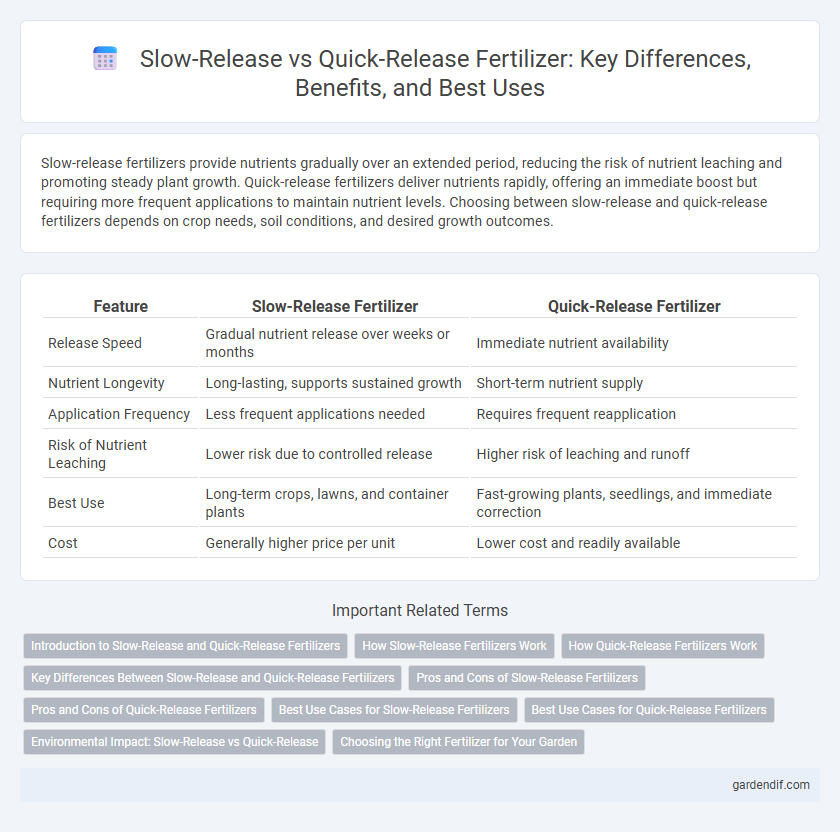
Slow-release fertilizer vs Quick-release fertilizer Illustration
Slow-release fertilizers provide nutrients gradually over an extended period, reducing the risk of nutrient leaching and promoting steady plant growth. Quick-release fertilizers deliver nutrients rapidly, offering an immediate boost but requiring more frequent applications to maintain nutrient levels. Choosing between slow-release and quick-release fertilizers depends on crop needs, soil conditions, and desired growth outcomes.
Table of Comparison
| Feature | Slow-Release Fertilizer | Quick-Release Fertilizer |
|---|---|---|
| Release Speed | Gradual nutrient release over weeks or months | Immediate nutrient availability |
| Nutrient Longevity | Long-lasting, supports sustained growth | Short-term nutrient supply |
| Application Frequency | Less frequent applications needed | Requires frequent reapplication |
| Risk of Nutrient Leaching | Lower risk due to controlled release | Higher risk of leaching and runoff |
| Best Use | Long-term crops, lawns, and container plants | Fast-growing plants, seedlings, and immediate correction |
| Cost | Generally higher price per unit | Lower cost and readily available |
Introduction to Slow-Release and Quick-Release Fertilizers
Slow-release fertilizers release nutrients gradually over time, providing a steady supply that improves plant growth and reduces nutrient loss through leaching. Quick-release fertilizers deliver nutrients rapidly, offering an immediate nutrient boost for fast-growing plants or to correct nutrient deficiencies quickly. Understanding the differences in nutrient release patterns helps optimize fertilization strategies for various crops and soil conditions.
How Slow-Release Fertilizers Work
Slow-release fertilizers work by gradually releasing nutrients over time through coatings or chemical formulations that control nutrient availability, reducing leaching and nutrient loss. These fertilizers provide a steady nutrient supply that aligns with plant uptake, enhancing efficiency and promoting sustained growth. The slow nutrient release minimizes environmental impact by preventing nutrient runoff commonly associated with quick-release fertilizers.
How Quick-Release Fertilizers Work
Quick-release fertilizers dissolve rapidly in water, making nutrients immediately available for plant uptake, which supports fast growth and quick recovery from nutrient deficiencies. These fertilizers typically contain soluble forms of nitrogen, phosphorus, and potassium, facilitating rapid absorption by roots. However, their quick dissolution can lead to nutrient leaching and requires frequent reapplication to maintain optimal soil fertility.
Key Differences Between Slow-Release and Quick-Release Fertilizers
Slow-release fertilizers provide nutrients over an extended period, reducing the risk of nutrient leaching and minimizing environmental impact, while quick-release fertilizers deliver nutrients rapidly for immediate plant uptake but may require more frequent applications. The nutrient availability in slow-release formulations is controlled by coating materials or chemical inhibitors, leading to sustained growth support, whereas quick-release types dissolve easily in water, causing a rapid but short-lived nutrient supply. Understanding these differences is crucial for optimizing fertilization strategies based on crop type, soil conditions, and desired growth rates.
Pros and Cons of Slow-Release Fertilizers
Slow-release fertilizers provide nutrients gradually, reducing the risk of nutrient leaching and minimizing environmental impact, making them ideal for sustained plant growth and reducing fertilizer application frequency. However, they typically have a higher upfront cost and slower initial nutrient availability compared to quick-release fertilizers, which may delay visible plant response. Their controlled nutrient release enhances efficiency in various agricultural and horticultural applications but requires careful selection based on specific crop needs and soil conditions.
Pros and Cons of Quick-Release Fertilizers
Quick-release fertilizers provide immediate nutrient availability, promoting rapid plant growth and quick correction of nutrient deficiencies. However, they carry a higher risk of nutrient leaching and can cause fertilizer burn due to sudden nutrient overload. Their fast action often requires frequent applications, increasing labor and cost compared to slow-release options.
Best Use Cases for Slow-Release Fertilizers
Slow-release fertilizers are best used in settings requiring prolonged nutrient availability, such as lawns, container plants, and orchards, where steady growth and minimal nutrient leaching are critical. Their controlled nutrient release aligns with plant uptake rates, reducing the frequency of application and lowering the risk of fertilizer burn. These fertilizers are also ideal for environmentally sensitive areas, as they minimize groundwater contamination compared to quick-release alternatives.
Best Use Cases for Quick-Release Fertilizers
Quick-release fertilizers are best used in scenarios where plants require immediate nutrient availability, such as during the early growth stages or to quickly address nutrient deficiencies. They are ideal for high-demand crops like vegetables and lawns needing rapid green-up and growth. Farmers and gardeners favor quick-release formulations for their ability to deliver nutrients instantly, promoting fast plant response and short-term yield improvement.
Environmental Impact: Slow-Release vs Quick-Release
Slow-release fertilizers minimize nutrient leaching and reduce groundwater contamination by releasing nutrients gradually, leading to less environmental pollution. Quick-release fertilizers often cause nutrient runoff and increased greenhouse gas emissions due to rapid nutrient availability and over-application risks. The sustained nutrient supply from slow-release formulations supports healthier soil microbiomes and reduces the frequency of fertilizer applications, promoting better environmental sustainability.
Choosing the Right Fertilizer for Your Garden
Slow-release fertilizer provides nutrients gradually over an extended period, reducing the risk of nutrient leaching and minimizing plant stress. Quick-release fertilizer delivers nutrients rapidly, offering an immediate boost but requiring more frequent applications to maintain optimal growth. Selecting the right fertilizer depends on your garden's specific needs, soil conditions, and plant types to ensure efficient nutrient availability and healthy vegetation.
Slow-release fertilizer vs Quick-release fertilizer Infographic

 gardendif.com
gardendif.com